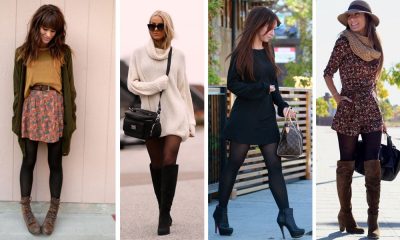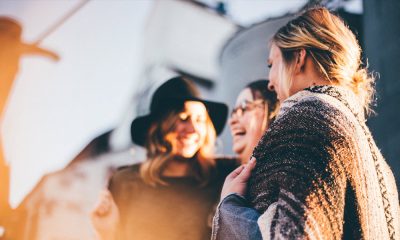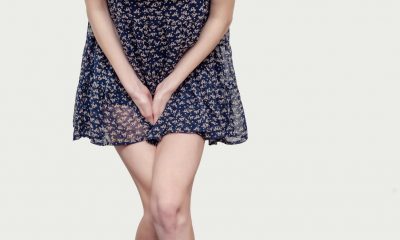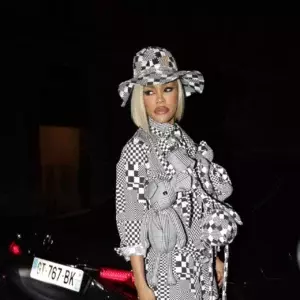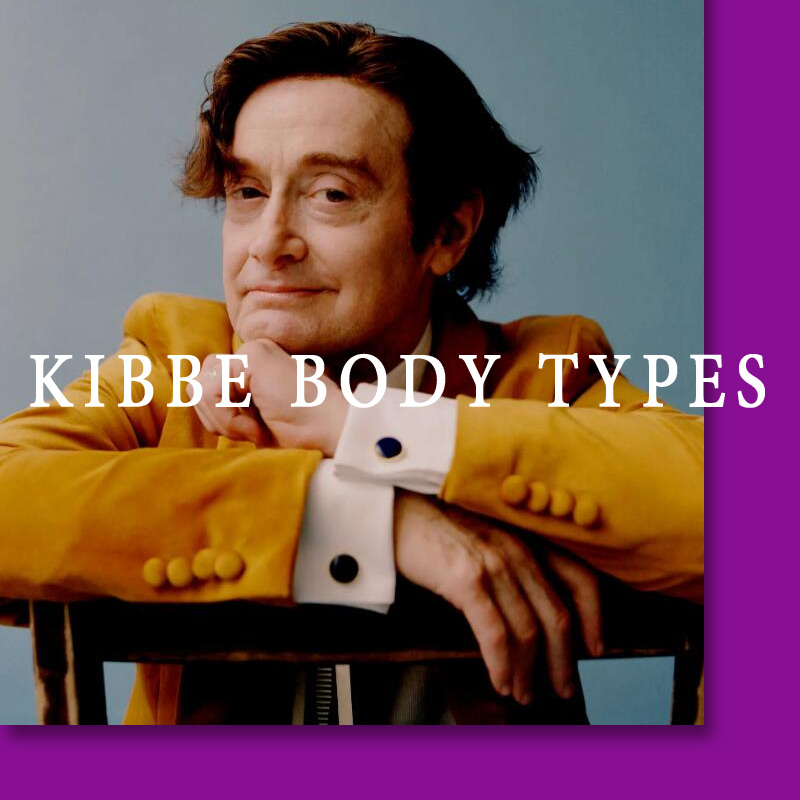
Discover the Kibbe Body Types System & Upgrade Your Style Identity
This article is all about using the Kibbe Body Type System to find your own Style Image through an assessment of your individual shape and your personality type.
We all have great fashion potential, but many of us simply don’t have enough personal information to make our best impression on the world.
So if you’re a fashion lover, who finds the plethora of fashion styles on offer in the modern world deeply confusing, read on and find out who you really are.
You’ll feel so much more relaxed when you know for certain what outfits suit you physically and psychologically!
And if you hate fashion and prefer to just wear your individual choice of clothing – that’s great, too! With the Kibbe system you can still identify which clothes suit you best and give you an attractive look – plus durability.
What is the goal of the Kibbe Body Type system?
When you look into your wardrobe do you find a selection of well-chosen mix and match colors and styles that all flatter your body type?
Or a mish-mash of trends, colors and fabrics that don’t make well-matched outfits!
Do you find it easy to pick out an attractive set of clothes to wear in just a couple of minutes?
Do you ever look at your outfit in comparison to the folks around you and wonder why your clothes don’t flatter you as much as theirs flatter them?
Don’t blame yourself. We don’t get any independent style and body type training and really, it’s ‘every woman for herself’ in the fashion styling stakes!
Some women seem to have a better understanding of what suits their body shape than others – the lucky few. And others have had fashion and design training that helps them wear the most flattering looks.
But most of us, who have less than standard shapes – extra tall, petite, curvy and not perfectly proportioned – just have to struggle with what’s on offer each season and make our best guess as to what to wear.
Wouldn’t you love to have the knowledge of a fashion stylist to get your own personal style sorted out once and for all?
Well, this step-by-step Kibbe Body Types introduction is the start of a wonderful journey to find your personal body type and style identity!
Forget that ‘nothing to wear’ feeling
All of us have suffered that sinking feeling when looking in the wardrobe and thinking we have, ‘nothing to wear’!
Why is that? Well, it’s a combination of not having the right size, fit, colors, styles and items for creating flattering outfits.
And we all wish we never made mistakes when purchasing clothes. But most of us are affected by moods and emotions when buying new clothes.
When you buy a silver llamé cut-out evening gown, you may be daydreaming about meeting your soulmate in an upscale nightclub – forgetting that you really need daywear!
You may be listening to a song you loved as a youngster when you suddenly decide to buy a batch of Y2K clothes that aren’t really the image you want to project in your work-place.
How to choose the most flattering clothes
And more than anything, most of us are unsure of which styles will flatter our good points and skim over our body shape ‘issues’.
Well, this is your chance to learn everything there is to know about developing your Personal Style Image using the updated Kibbe Body Types introduction.
It will fill in all the gaps about your fashion buying efficiency – so you can build up a useful, flattering and value-for-money wardrobe.
And that’s the key to creating your own secure style identity and raising your game in the personal presentation stakes.
More than anything, wearing the best outfits to flatter your body type is a way to feel fully confident and successful in your daily life!
Get ‘added value’ from your outfits
We all see people whose personal style gives them, ‘added value’, because they select clothes and accessories that really flatter them and give them an outstanding image.
And this is your opportunity to learn all about yourself and your best fashion choices.
The time you give to learning about your own body type will be an investment in a stress-free and enjoyable fashion future on many different levels!
Now, more than ever, is the time to avoid buying clothes that don’t fit well, are the wrong color for you, and don’t fit in to your overall style identity.
By following this Kibbe Body Types introduction, you can stop wasting your money on fashion mistakes that only leave you feeling bad.
And you’ll also prevent the current wasting of the earth’s resources, as you build up your personal self-confidence!
So first of all, you need to get to know yourself and how popular culture has shaped your personality.
Find your Basic Personal Style Preferences
This is a great way towards identifying what styles you tend to go for. And the Kibbe system believes that anyone can wear any style, as long as you know how to tweak it to favor your body type.
Spend a little time thinking back through your life to remember which music, movies, celebrities, friends and family caught you attention for the fashions they wore.
These are memories of style images that you always wanted to emulate when you were a child or adolescent.
And remembering them will form a part of the personal style identity that you create after you’ve done the Kibbe Body Type Test.
What is the Kibbe Body Type System in Fashion Styling?
The Kibbe body type system is an ‘image identifying method’ which David Kibbe set out in his 1980’s text-book, Metamorphis.

It started from the idea that there are three main aspects that give each person an individual and different appearance. And these are:
- Your bone structure – face and body
- Your flesh distribution over the bones
- Your facial features
Kibbe looked at the balance of two contrasting features which he called Yin and Yang, from the Chinese system of explaining two contrasting and complementary aspects of one particular thing – like two different sides of one coin.
It used to be said that Yin is female and Yang is male, but these days we know that is not an accurate way to understand the symbols.
Yin and Yang should not be thought of as male/female characteristics. This is incorrect and misleading in identifying your Personal Style Image.
It will help you more if you think of Yin and Yang as the contrast between softness, rounded shapes or delicate bone structure and Yang as sharp, angular and long lines.
In addition, ‘flesh’ is a neutral term when used in the Kibbe system and has nothing whatsoever to do with a person’s weight or body mass index.
Instead it refers to the type of flesh on your body, for example, are you lean and well-muscled or do you have soft flesh and so forth.
Kibbe Body Types Introduction – The five main Kibbe body types
So Kibbe examined body types and came up with five, general, style image categories called:
- Classic
- Dramatic
- Gamine
- Natural
- Romantic
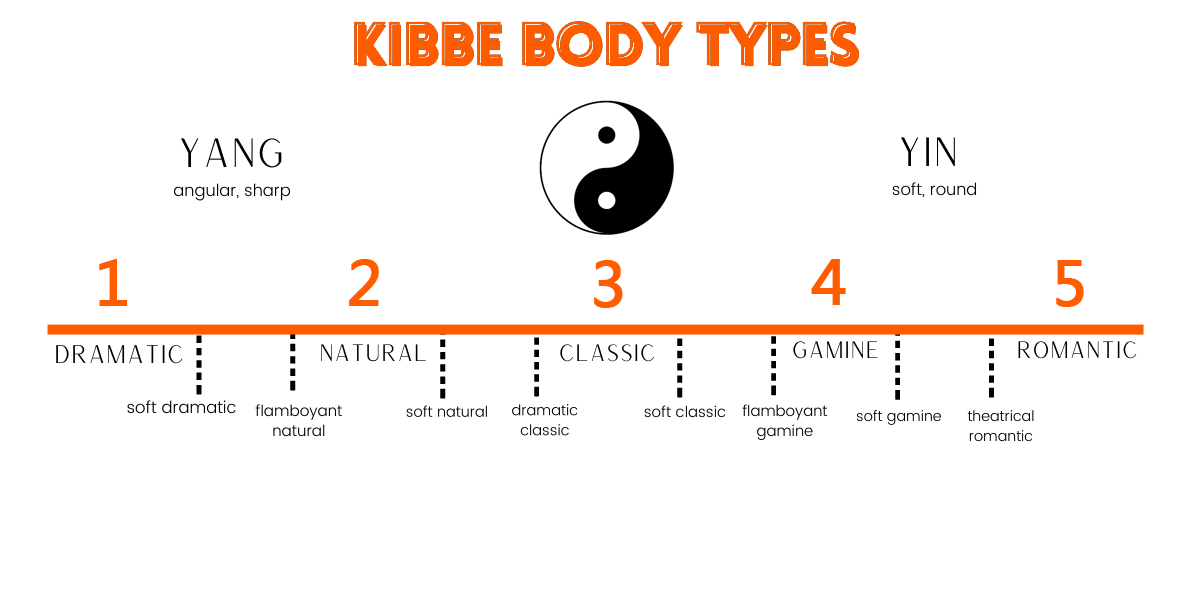
And within these groups, he created eight subtypes, making a total of thirteen possible style identity options.
Don’t worry if this seems a lot to follow at first, when you see the photos and descriptions in the Kibbe Body Types section, you’ll find it easy to understand.
A Simple Look at the Kibbe Body Types
What are the 13 Kibbe Body Types?
There are 5 basic types in the Kibbe system, which are underpinned by 13 style image categories!
13 Styles of Kibbe Body Types
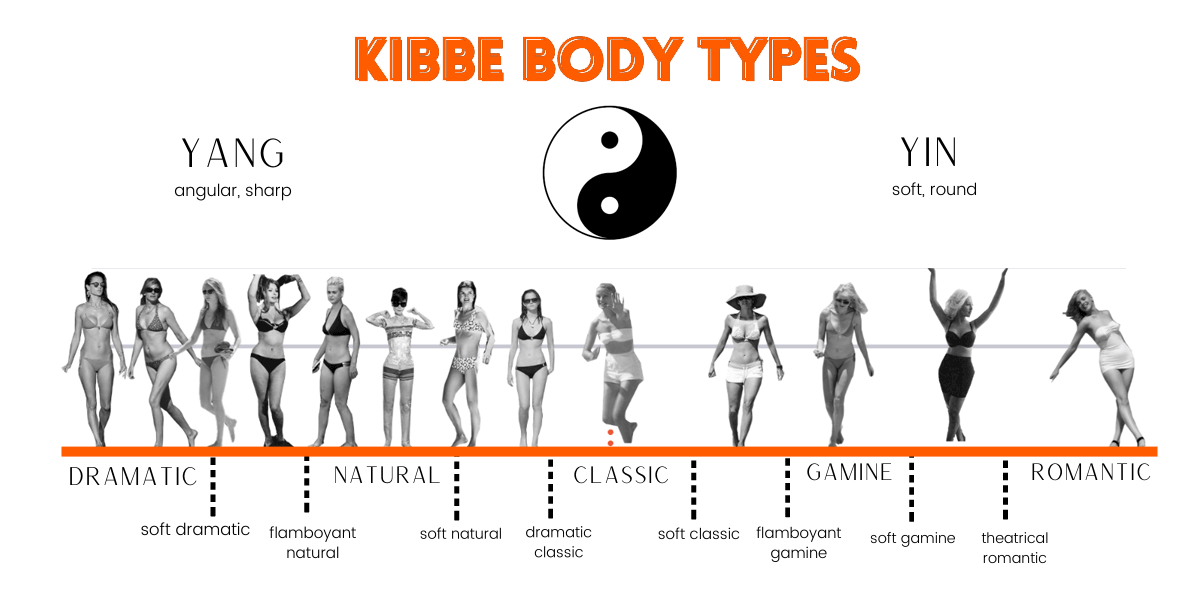
In recent years, we’ve been used to thinking of body shapes in traditional terms of pear, apple, upside-down triangle, the rectangular and the hourglass.
But you’ll find the updated Kibbe Image Identity System far more nuanced, so it’s easier to find your exact Style Image and really improve your fashion style.
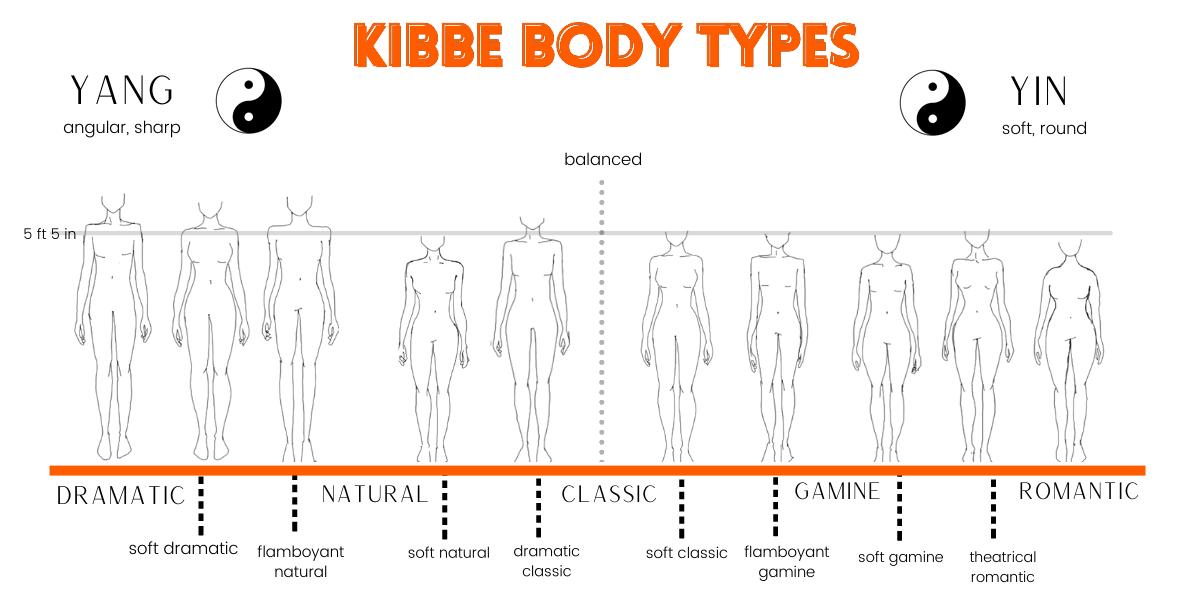
In particular, if you’ve just given up on trying to dress yourself in line with current fashion trends, this system makes it easy to incorporate contemporary styles into your wardrobe and freshen up your whole image!
This fashion image system encourages you to embrace your natural body shape and know how to look your best for all occasions.
How does Kibbe Body Type system work?
It does this by considering everything from your facial features, your overall bone structure and how your flesh is ‘spread’ over it – to your personality and your individual style preferences!
Moreover, the Kibbe Body Type System looks at the differences between soft and curvy body shapes and more angular and lean body types.
Each of the thirteen Kibbe Image Identity Types or Style Images includes your preferred styles of clothing, make-up, hairstyle, face shape and everything that goes together to make you a unique individual.
Origin of the Kibbe Body Type system
The foundation for the updated Kibbe Body Type system was David Kibbe’s book, Metamorphosis: Discover Your Image Identity & Dazzle as Only You Can! published in 1987.
It is a little outdated for current times and isn’t available to buy any more, but it formed the foundation for an immensely useful, modernized system of identifying body types, which is studied by the majority of today’s professional ‘fashion stylists’.
The basic idea of Kibbe was that anyone can wear any style or accessory, regardless of their body type – as long as it fits with the individual’s unique, personal style identity.
What are the practical benefits the Kibbe Body Type System?
There are lots of solid advantages to be gained from understanding the Kibbe system, such as:
- Allowing you to accurately identify your own personal shape and to wear flattering clothes
- To understand why you tend to choose particular styles and whether that could be improved
- Discover why some styles never give you a good fit
- Learn to love your unique body and how to present yourself with style and confidence
- Be able to wear most fashion trends by knowing how to tweak your outfits to your look
How did David Kibbe view the traditional body type system?
Kibbe knew that the established body shape ID method was not fit for use, because it was over-simplified.
And he saw that his had led to manufacturers offering styles and fashions which only really suited a narrow band of women.
So he aimed to reduce women being overly-focused on copying one major fashion style, which was like a uniform that only suited a fraction of the women who wore it at any one time.
And instead, he helped women focus on their own personal style and body shape in a highly positive way, so they could create flattering outfits that better suited their shape, size and personality.
He could see that forcing the range of different shaped women to try and copy a narrow range of ‘celebrity fashion clothing’ was causing a lot of anxiety amongst the majority who didn’t have a ‘model’ figure.
And this was probably the first system to encourage women to love their body and focus on flattering clothes for their individual shape and personality – rather than trying to force all women into an unattainable ‘ideal’ shape and style!
Natural bodies are best
This view doesn’t approve of artificially changing your face or natural body shape with surgery or obsessive gym exercises to create a distorted body shape.
Unfortunately, this practice is now being virtually forced upon us by almost daily pictures of Kim Kardashian, Katy Price and other infamous celebrities.
So following the Kibbe Style Identity system means realizing that you are the, ‘full package’ just as you are.
And you just need to learn who you are and then discover what styles and shapes bring out your best look every day!
So stick with this Kibbe body types introduction and you could change your life!
Do Kibbe style ID’s change with time?
Kibbe believes that your body type/style image ID can’t change and to get the best evaluation, you should do the test after the age of 25.
So it won’t suddenly change if you have children or experience a rapid weight gain or loss and as you age, your understanding of what clothing gives you the best silhouette will increase.
And when you’ve done the Kibbe Body Type test here, and know your ID, you can refer to the various Style Guides that show you exactly which trends and shapes are best for you!
So why not take the time to find your individual body type here and be your best-dressed self every day!
Getting started with the Kibbe Body Type System
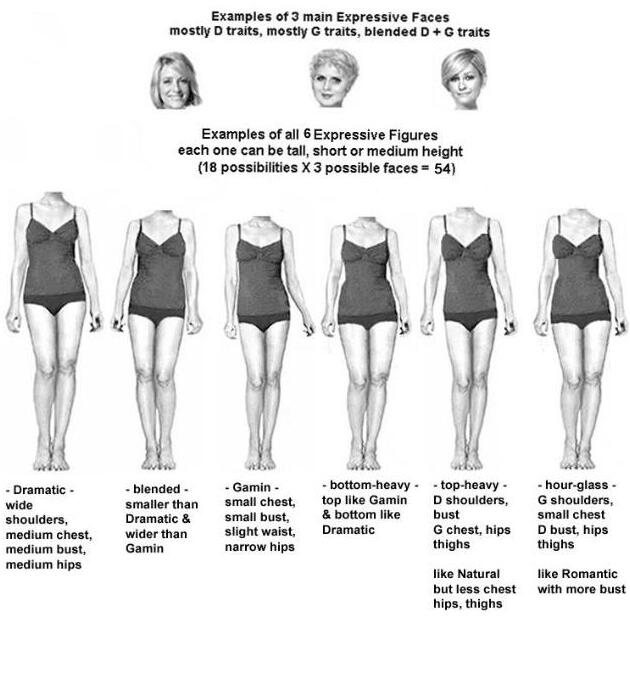
First of all, you need to avoid bias that will affect you if you still believe that Yin is ‘female’ and Yang is ‘male’.
This misunderstanding could lead you to unconscious bias where you tend toward choosing Yin characteristics solely because you are female and want to emphasize that.
And that could mean you end up with the wrong body type/style ID. If you carry out a thoughtful evaluation of the Kibbe system, it will allow you to ‘hide’ your least favorite areas and focus on your ‘best bits’!
Yin & Yang as part of the Kibbe Body Types introduction
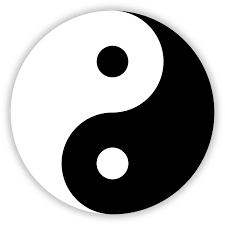
In Chinese philosophy Yin and Yang symbolize the two opposite principles and forces that are thought to exist in all things.
These can be dark and light, strong and weak, soft and hard or many other properties, but they complement each other to create a single entity.
So an individual body, face and personal style will be composed of differing characteristics that taken together make up a whole person.
So don’t think of Yin as female and Yang as male, or you will lose your way. It’s better to see Yin as soft and Yang as angular etc., and realize that we are all made up of a blend of Yin and Yang.
Yin & Yang body characteristics in detail in the Kibbe Body Types system
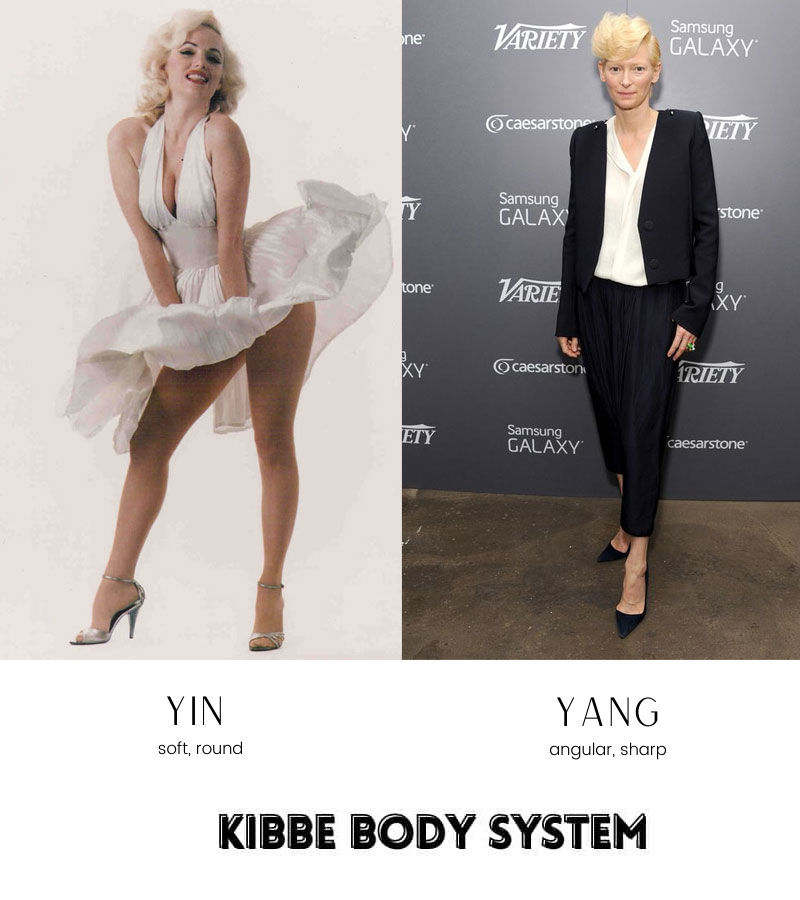

YIN (soft/round)
So in the Yin section you would include the hourglass figure, flowing silhouettes, rounded forms, smoothness and soft edges.
Yin of Kibbe Body Types system
- Fleshy
- Dainty
- Soft jawlines
- Delicate bone structure
- Rounded facial features
- Petite or short body
- Full lips
- Large, soft eyes
- Sloped shoulders
- Soft round cheeks
- Soft, flowing fabrics
- Round or ‘button’ nose
YANG (sharp/vertical)
And the Yang section includes geometric rectangles and triangles etc., harsh lines, extra-long body shapes, vertical stripes and angular lines.
Yang of Kibbe Body Types system
- Almond or narrow eyes
- Angular face
- Angular, lean, straight
- Broad or angular shoulders
- Muscular physique
- High or sharp cheekbones
- Defined sharp jawline
- Sharpness
- Sloped or prominent nose
- Structured fabrics/tailored clothes
- Tall, vertical
- Thin straight lips
You’ll soon gain an understanding of the properties of Yin and Yang and how they are expressed in your face, body and style preferences!
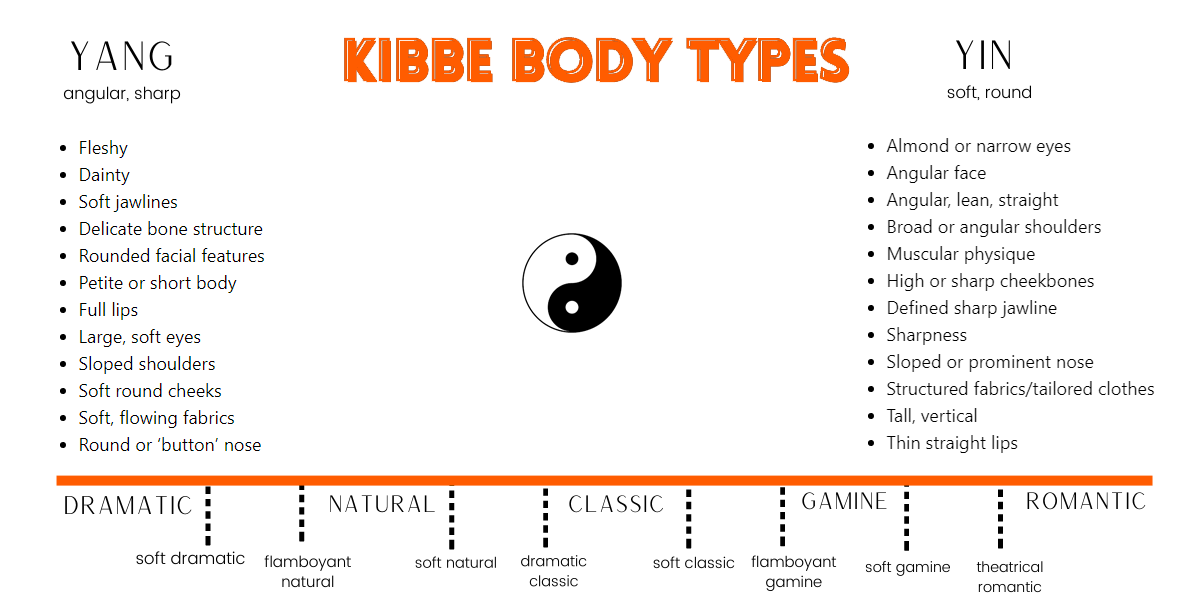
Image Chart
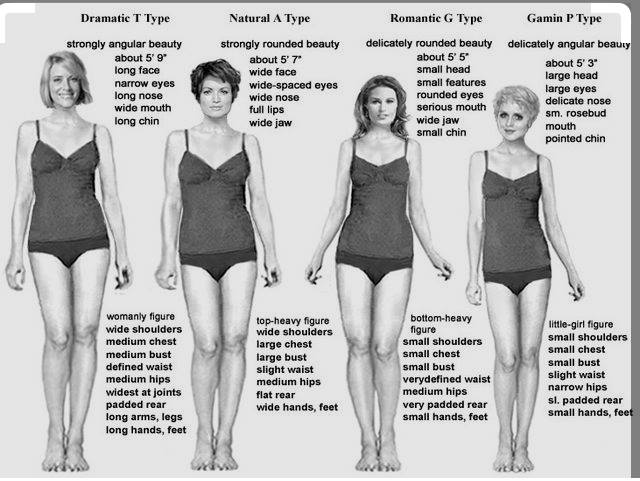
Sensuous Yin – larger eyes, a curvy, hourglass figure, fuller lips and more ‘sexy’
Petite Yin – dainty-looking, with small features, feet, nose, hands and shorter than average and a delicate bone-structure
Sharp Yang – taller, with elongated figure, angular lines, sharper features and lacking waist definition
Soft Yang – broad features, wider body shape with a little verticality, blunter features and edges
The Kibbe Body Types introduction – meaning of ‘Contrast’ and ‘Blend’
As we are all a mixture of Yin and Yang characteristics, the words ‘contrast’ and ‘blend’ explain how they are balanced between your body, face and overall style in each section.
For example, a ‘blended’ figure/style image has a balanced mixture of Yin and Yang in each physical aspect and therefore, doesn’t qualify as only Yin, or only Yang.
Example of a ‘blended’ Kibbe Body Type
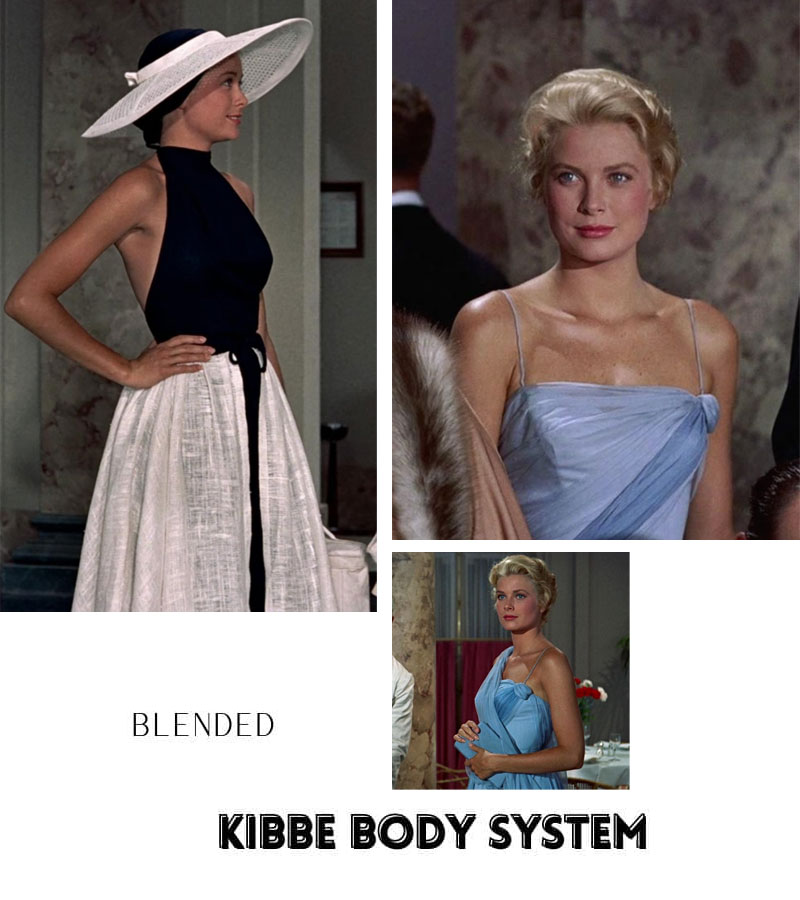
Actress and Princess of Monaco, Grace Kelley was the perfect example of a blended Kibbe body shape. Kibbe classified her as a Classic and at times, Soft Classic, type.
This was illustrated by her symmetrical skeleton, which also had rounded, soft edges. In addition, Grace’s features were quite delicate, but she didn’t have a well-defined waistline.
And whilst her facial features were mostly soft, she also had a nicely defined nose. Therefore, in each Kibbe category i.e. bone structure, distribution of flesh, and facial features, she had well blended Yin and Yang characteristics.
Example of a ‘contrasted’ Kibbe Body Type
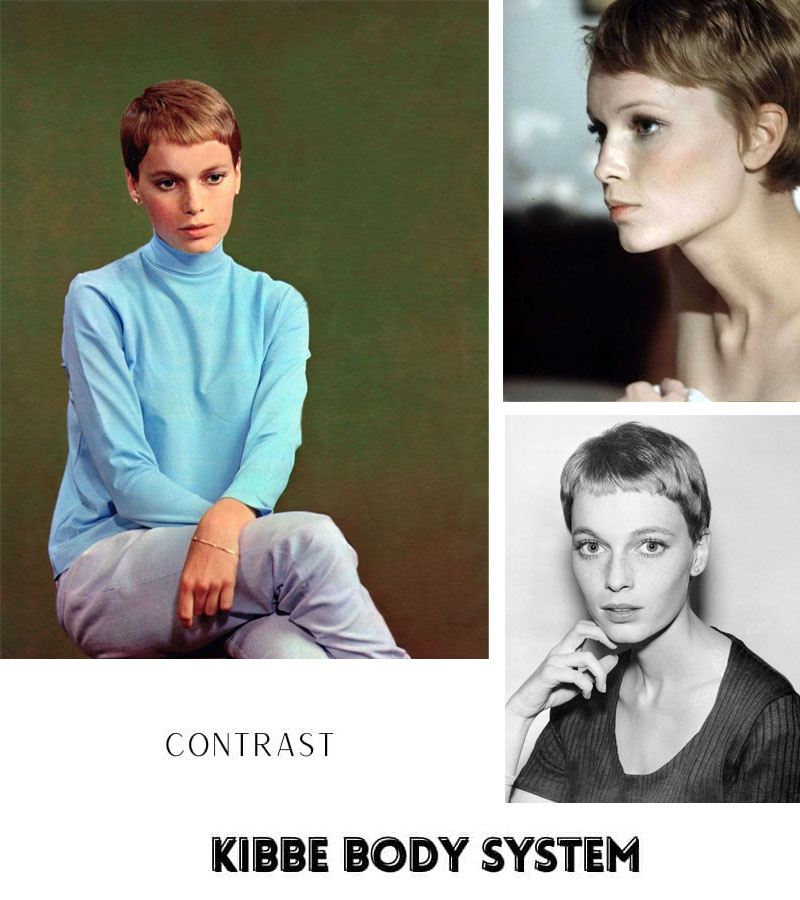
Take a look at the above chart and you should be able to see that the most ‘contrasted’ type is the gamine.
Gamine is the French word for meaning, ‘a slim, often boyish, elegant young woman who is, or is perceived to be, mischievous, teasing or sexually appealing.’
And the appealing Gamine type usually has an equal mix of Yin and Yang features. So like Tilda Swinton, the Yang body shape doesn’t have noticeable bust, waist or hips.
However, when you examine Tilda’s large eyes and softly shaped eyebrows, you can see the Yin aspects of her face. And these are complemented by a well-defined bone structure and a lean distribution of flesh.
Each of the 3 categories – bone structure, body flesh and facial features, (including bone and flesh), has a dominant Yin or a dominant Yang aspect.
This is a key aspect of understanding the Kibbe Body Types introduction showing how to evaluate yourself accurately.
What are the 5 main types of Kibbe Body Type/Image in detail?
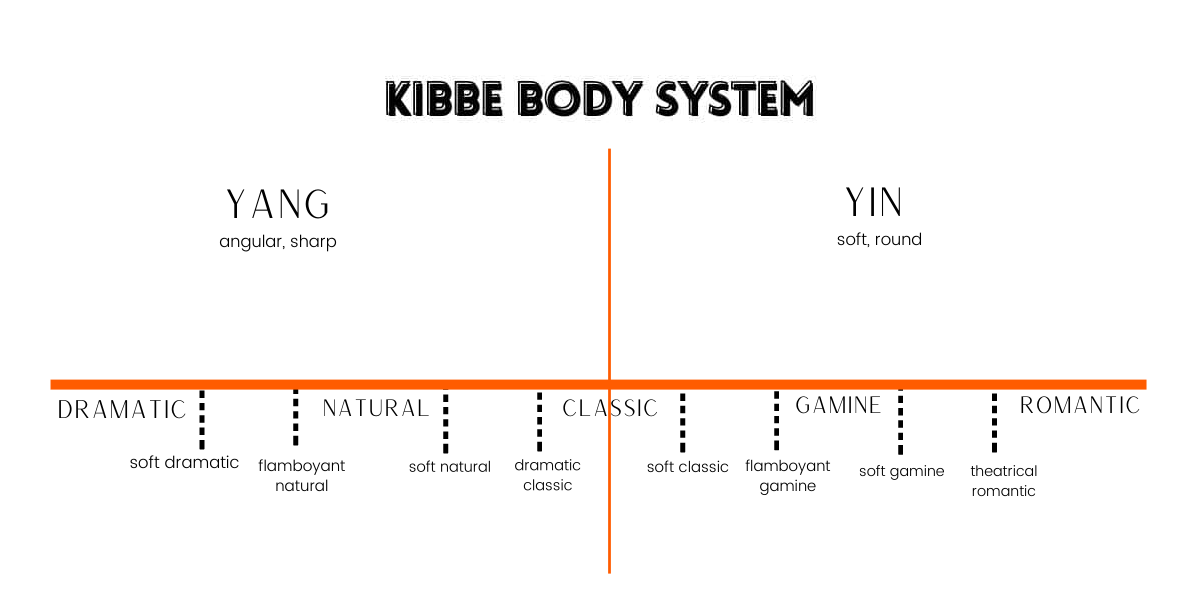
The 5 main Kibbe Body Types are:-
- Classic
- Dramatic
- Gamine
- Natural
- Romantic
And Kibbe divided these into 13 individual types.
- Dramatic
- Soft Dramatic
- Flamboyant Natural
- Natural
- Soft Natural
- Dramatic Classic
- Classic
- Soft Classic
- Flamboyant Gamine
- Gamine
- Soft Gamine
- Theatrical Romantic
- Romantic
1. Classic Kibbe Body Type
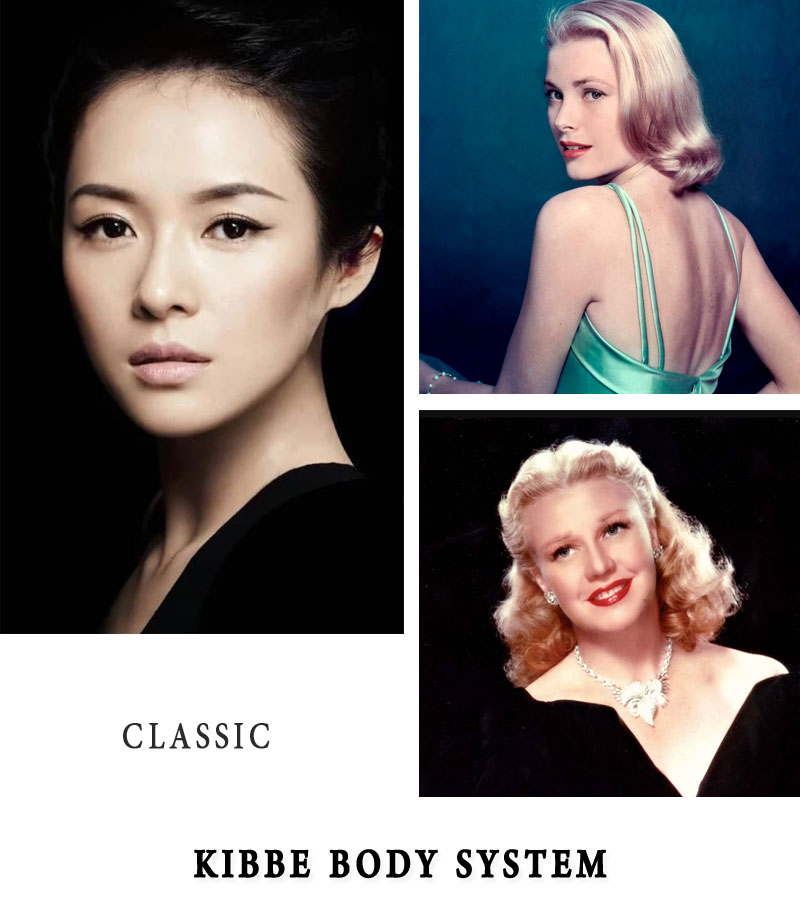
The Classic image identity is as 50/50 balance of Yin and Yang and is known as a blended type. Each section of the 3 main aspects contains an even balance of sharp and soft characteristics. And altogether, this symmetry and ‘blend’ creates a look which we find refined and visually appealing.
Examples include: Zhang Ziyi, Grace Kelly and Ginger Rogers
Classic Body Type Features:
The Classic Kibbe individual has a well-proportioned figure and is not long-waisted or short-waisted.
They are of moderate height, measuring somewhere between 5’ 4” – 5’ 7”.
They have a nice balance between the bust and hip measurements, but don’t have a noticeably small waist. In fact they are a little straight in the midriff.
Their facial features are symmetrical and angular, so that overall, they have a lithe, slender look. And as we all know, this body type, with perfect symmetry and balance is quite rare!
Recently, Kibbe has decided to re-classify Grace Kelly as a Soft Classic.
2. Dramatic
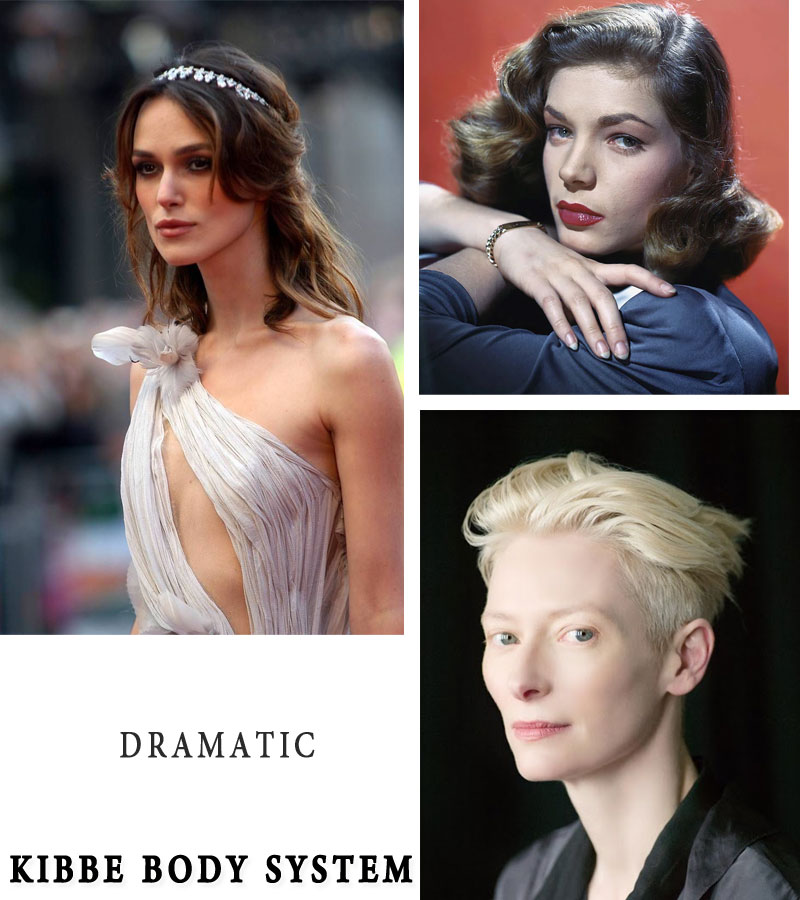
The dramatic body type is fairly easy to spot and most of the top models are in this category, with sharp Yang features predominating.
This body type is tall, angular and has a long vertical line, so lots of women shy away from identifying as a ‘Dramatic’, because they suppose it marks them out as too, ‘masculine’.
But there’s no link at all between Dramatic and masculine, so avoid being biased away from correct answers when you do the body ID test.
Examples include: Kiera Knightly, Tilda Swinton, Joan Crawford, Katherine Hepburn and Lauren Bacall.
Dramatic Body Type Features:
This type is tall, often more than 5’ 7”, with a lean frame, noticeable bone structure and long limbs. Overall they are narrow with a long, vertical line and a low, waist-to-hip ratio.
3. Gamine
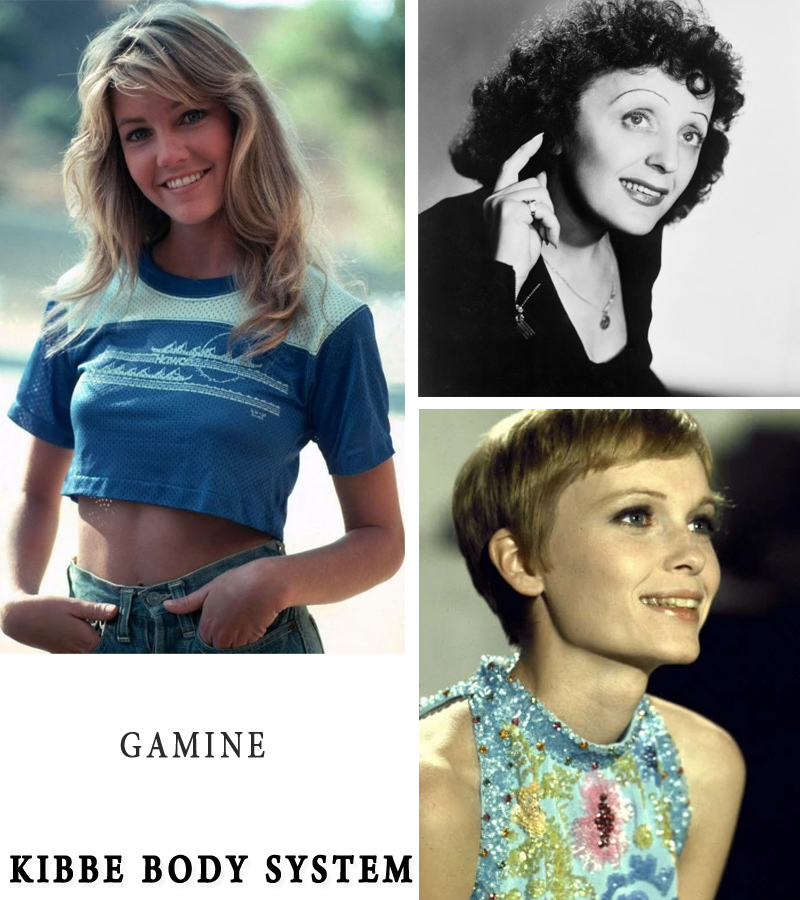
The Gamine body type is another balance of Yin and Yang, but in a slightly different way. The obvious difference is that there’s no blending in this type and what you are looking for is either Yin or Yang in each area of investigation.
So Gamine types may have a sharp, Yang nose, round, full, Yin eyes with straight, ‘widow brows’ which are Yin. This facial appearance is typical of the exaggerated look of Manga comic characters.
And this means that there’s plenty of contrast between Yin and Yang in the skeleton type, flesh distribution and face.
Examples include: Heather Locklear Mia Farrow, Edith Piaf, Jean Seberg
Gamine Body Type Features:
This body type is usually under the height of 5’ 5” and often includes petite women. The Gamine has a slender, wiry frame and may have a set of well-toned muscles.
The skeletal type is dainty, angular and narrow creating a delicate look. And their facial features often have good cheekbones, taut cheeks, moderate lips and large eyes.
4. Natural
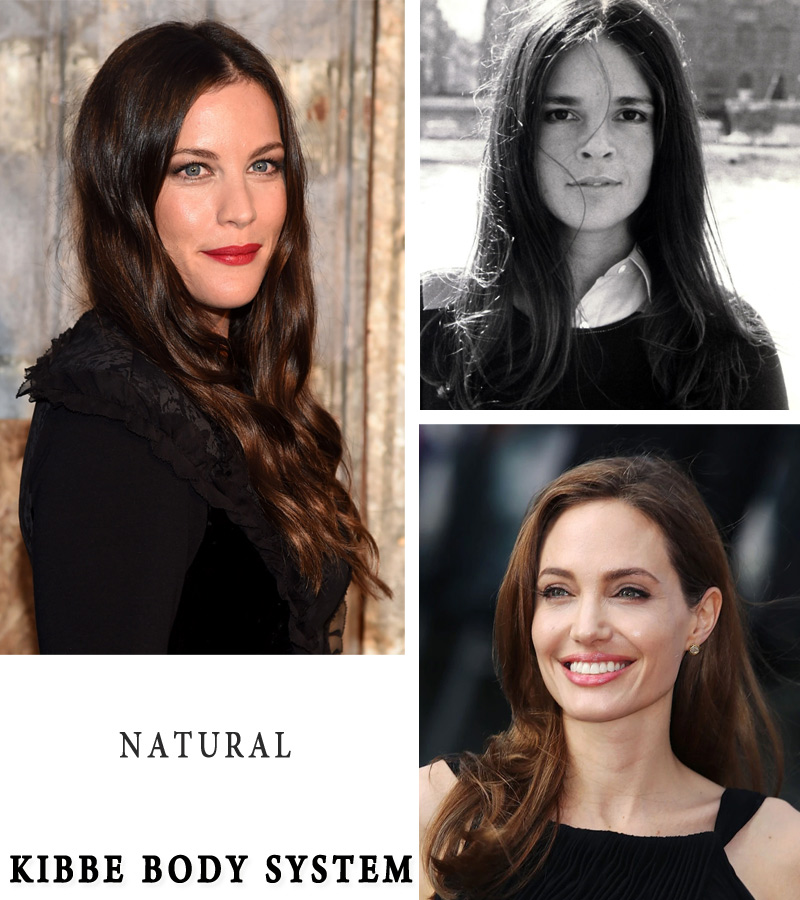
Soft Yang is the best way to describe the Natural body identity. It has blunt edges, but often shows some of the long vertical line of the Dramatic type. Features tend to be horizontal and height may be from high medium to tall, without being narrow boned. This type has strong shoulders.
Examples include: Angelina Jolie, Ali McGraw Liv Tyler
Natural Body Type Features
The Natural body type is medium to tall in stature with a good physique, a square outline and a fairly lean flesh distribution.
Their features are blunt-edged and angular and the facial features often include a straight, angled nose, taut cheeks and medium lip volume. Naturals are usually slender with a toned musculature.
5. Romantic
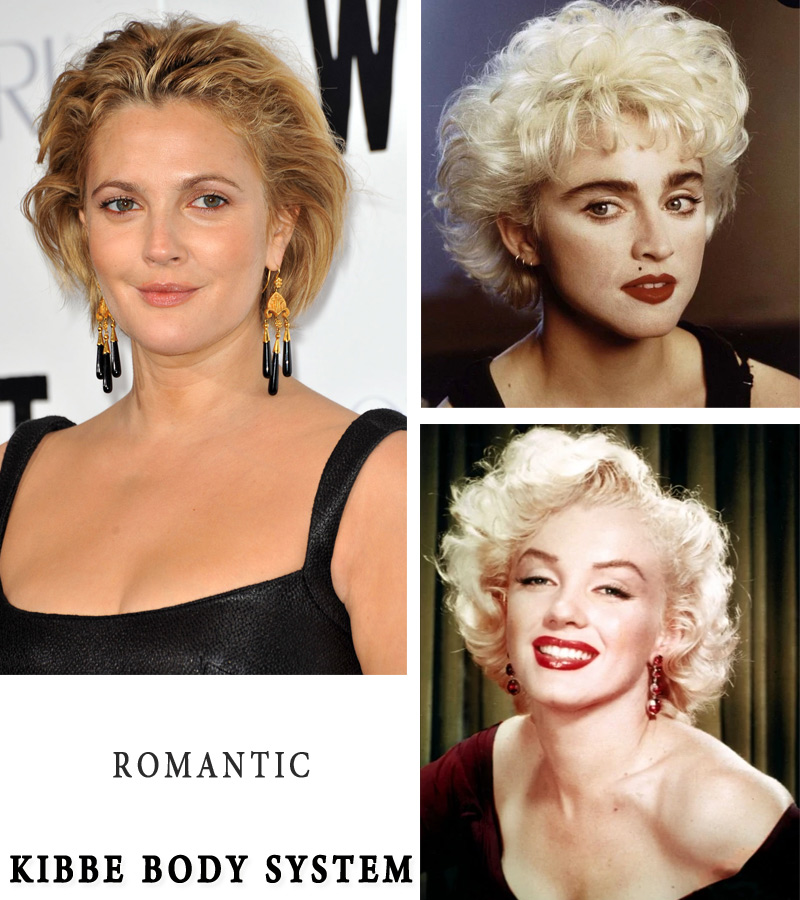
The Romantic body type includes plenty of sensuous Yin, by which I mean curves, an hourglass figure, rounded edges and a generally voluptuous shape.
Marilyn Monroe was the epitome of the romantic body shape, including her flesh distribution, her facial features and her bone structure, which are all rounded and soft.
Romantic Body Type Features:
Romantics usually have smaller bones and limbs and even if they don’t have a full, hourglass figure their frame is naturally rounded and dainty.
Kibbe described this as, ‘double curve’, which doesn’t mean a highly curvy shape, but refers to something more like a softly, snowman-like silhouette.
Examples include: Madonna, Christina Ricci, Drew Barrymore and Marilyn Monroe
David Kibbe’s recommendation for Romantics
As Romantics are curvy, without having much flesh on their body, Kibbe recommends them to wear figure hugging clothes that drape closely around the body. This highlights the areas of appealing flesh and the lean areas in between.
The 13 Kibbe Body Types
- Classic (C )
- Soft Classic (SC)
- Dramatic (D)
- Soft Dramatic (SD)
- Dramatic Classic (DC)
- Gamine (G)
- Soft Gamine (SG)
- Flamboyant Gamine (FG)
- Natural (N)
- Soft Natural (SN)
- Flamboyant Natural (FN)
- Romantic (R )
- Theatrical Romantic (TR)
| Kibbe Types | Bone Structure | Facial Flesh | Body Flesh |
| Classic (C) | Balanced | Balanced | Balanced |
| Soft Classic (SC) | Balanced | Yin (Petite or Sensuous) | Yin (Petite or Sensuous) |
| Dramatic (D) | Angular Yang | Angular Yang | Angular Yang |
| Soft Dramatic (SD) | Angular Yang | Sensuous Yin | Sensuous Yin |
| Flamboyant Natural (FN) | Angular Yang | Soft Yang | Soft Yang |
| Natural (N) | Soft Yang | Soft Yang | Soft Yang |
| Soft Natural (SN) | Soft Yang | Yin (Petite or Sensuous) | Yin (Petite or Sensuous) |
| Dramatic Classic (DC) | Angular Yang | Balanced | Balanced |
| Flamboyant Gamine (FG) | Angular Yang | Yin (Petite or Sensuous) | Yin (Petite or Sensuous) |
| Gamine (G) | Angular Yang | Angular Yang | Sensuous Yin |
| Soft Gamine (SG) | Angular Yang | Yin (Petite or Sensuous) | Yin (Petite or Sensuous) |
| Romantic (R) | Sensuous Yin | Sensuous Yin | Sensuous Yin |
| Theatrical Romantic (TR) | Sensuous Yin | Yin (Petite or Sensuous) | Yin (Petite or Sensuous) |
And now here are the 8 sub-groups that underpin the 5 main types to create 13 Kibbe style identities!
1. Soft Classic (SC) – A balanced body type with a dash of Yin
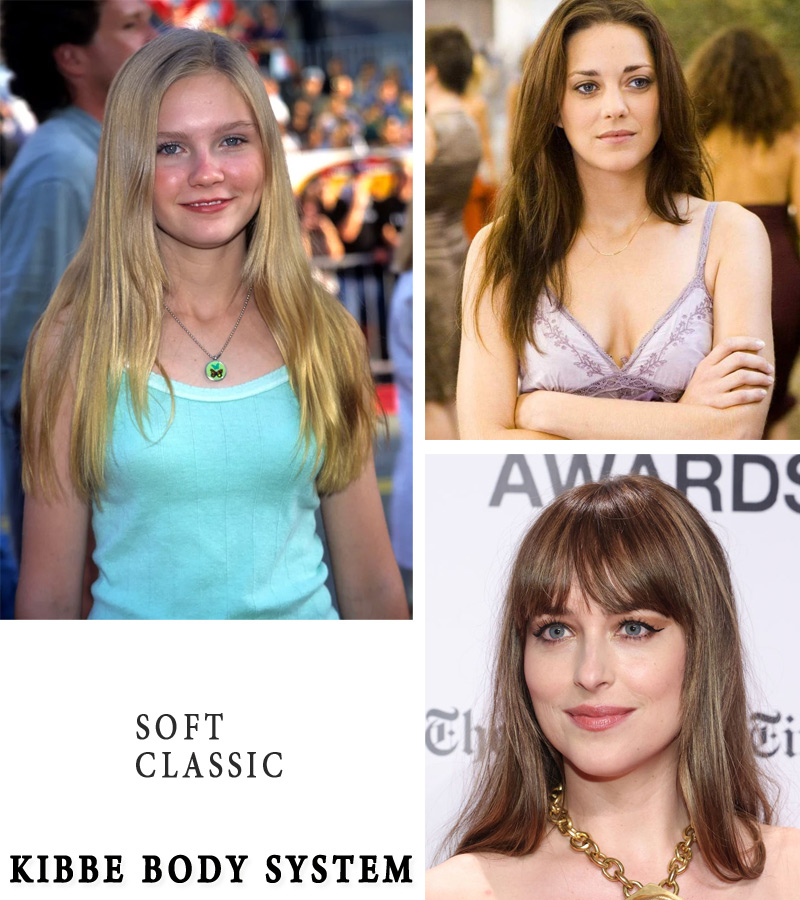
Along with balanced features and classically, balanced body shapes, Soft Classic types have a little more overall softness.
This is often seen in slightly sloped shoulders and soft edges and facial features that are moderate, although they can have a wide jaw or nose.
Their bodies don’t fall into the categories of either, ‘narrow’ or ‘broad’ and their limbs aren’t, ‘long’ or ‘short’. The image they tend to project is refined and well-balanced.
They may well have curves, but not enough to distort the balanced shape. A Soft Classic individual will be of medium height – mostly up to about 5’ 6”.
Examples include: Meryl Streep, Dakota Johnson, Kirsten Dunst and Marion Cotillard.
2. Soft Dramatic (SD) – Sharply Yang plus Sensuous Yin
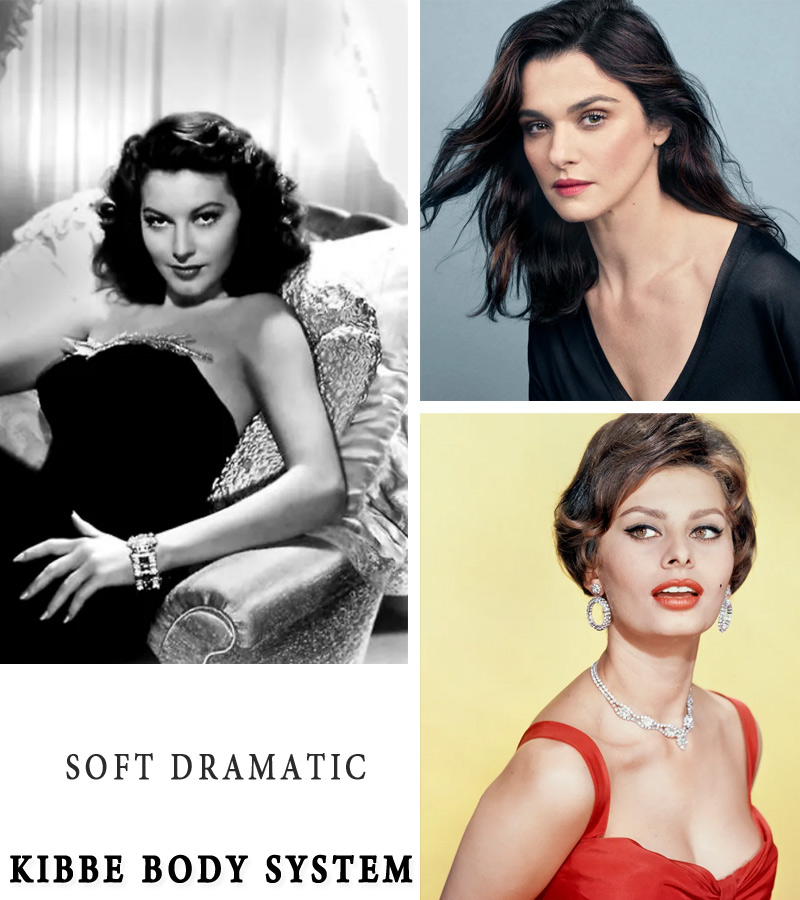
Soft Dramatic figures have an intriguing combo of narrow, elongated frame, which is Yang, and noticeable curves – Sensuous Yin.
Despite having strong shoulders, their long frame with curves keeps them in the Soft Dramatic group.
Soft Dramatic body types are usually taller than 5’ 5” and have well-defined hips and bust.
Examples include: Ava Gardner, Sofia Loren, Rachel Weiss
3. Dramatic Classic (DC) – A balanced body type underpinned by Yang characteristics
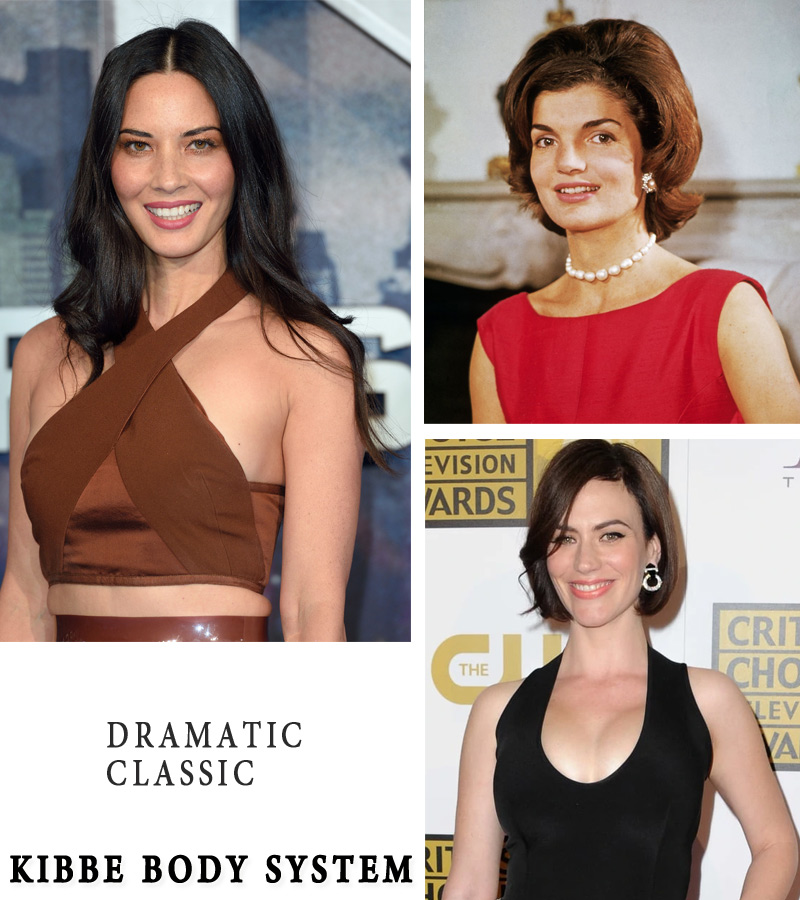
The Dramatic Classic body shape is a balanced type often with long limbs.
However, they don’t give the impression of having an extra-long vertical line because their hips and shoulders create a nice symmetry.
You can recognize the Yang aspect in their lightly angled edges and a medium height up to 5’ 7”, with well-proportioned hip, waist and bust measurements.
It’s mostly classically balanced with a few dramatic, angled Yin traits.
Examples include: Maggie Siff, Courtney Cox, Olivia Munn, and the iconic Jackie Kennedy/Onassis
4. Soft Gamine (SG) – A Yin and Yang mix leaning toward Yin
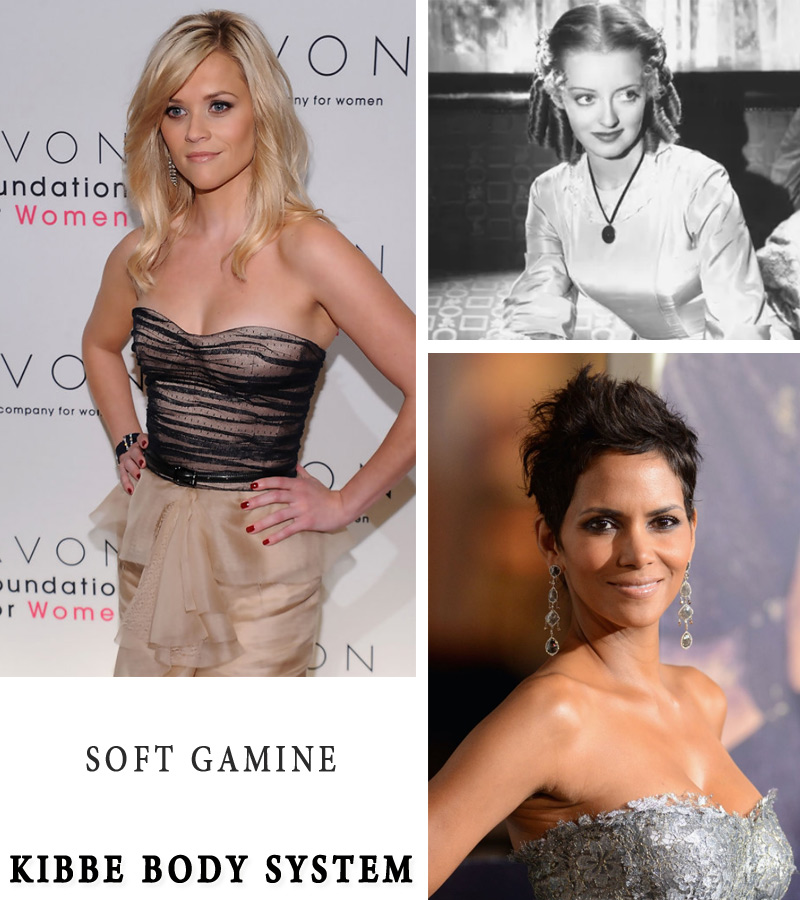
The Soft Gamine body type is always petite, which is Yin and has a dainty, narrow frame and probably angled shoulders, which are both Yang.
This type is small, with compact curviness and not noticeably ‘thin’, although they are narrower than the Romantic type.
All Gamines are shorter than 5’ 5” and Soft Gamines have a dainty bone structure, with small hands and feet. They also have dainty facial features, sometimes looking broad.
Soft Gamines often have full cheeks, medium to full lips and large eyes, but not always. And they may well have fleshy curves and full bust and hip shaping, with a moderate waistline.
Examples include: Halle Berry, Reese Witherspoon, Winona Ryder, the Olsen Twins, Judy Garland and Bette Davis
5. Flamboyant Gamine (FG) – A Mix of Yin & Yang with a Yang emphasis
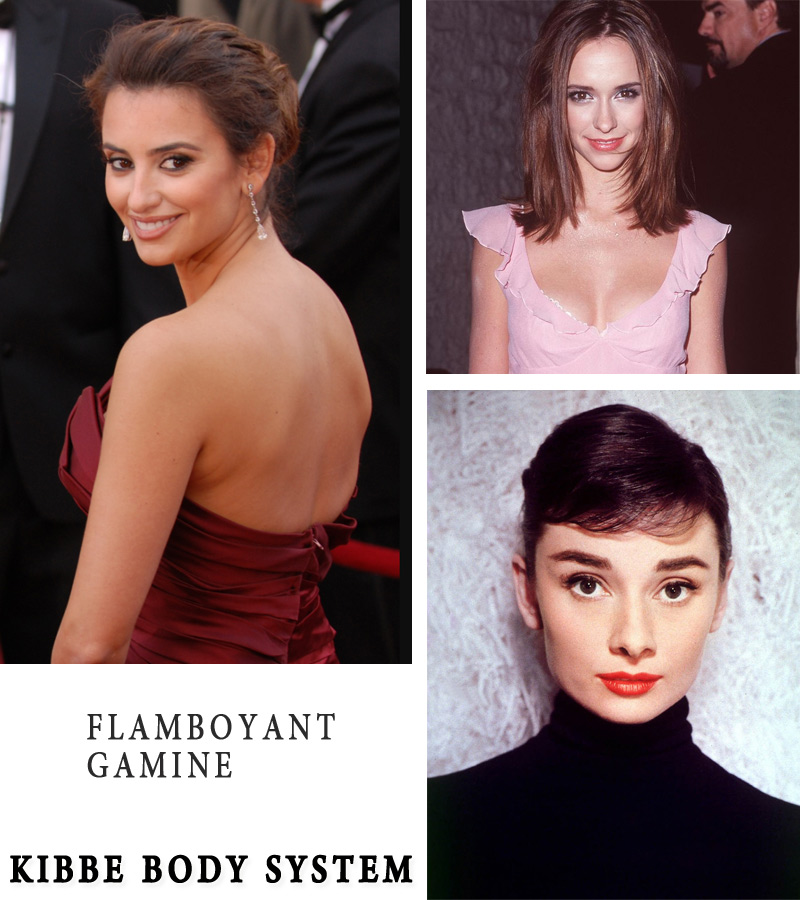
The Flamboyant Gamine body combines a petite stature under 5’ 5”, with a narrow frame that doesn’t show much curviness or waistline.
The FG body is straight with noticeably long vertical legs. And their facial features have Yin, large eyes, with Yang, well-defined jawlines and noses and medium-full lips.
Examples include: Liza Minelli, Penelope Cruz, Audrey Hepburn and Jennifer Love Hewitt
6. Soft Natural (SN) – Soft Yang with Yin touches
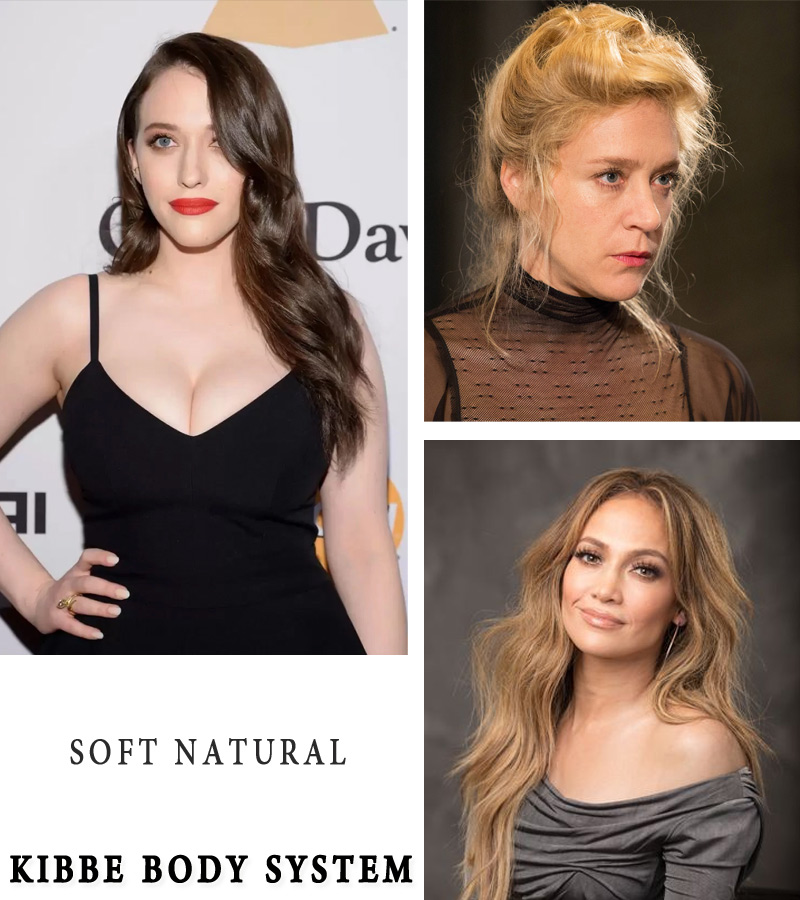
The Soft Natural body type has a wide skeleton and well-developed curves, with broader shoulders. This creates a noticeable horizontal line to the body shape.
Soft Naturals can be medium to tall in height, but they don’t have a long vertical line because their width balances out their height.
Often compared with Romantics, the Soft Natural body shape differs because of its wider bone structure. This can make the Soft Natural appear curvier than the Romantic body type, owing to blunt lines softened by flesh.
Examples include: Chloe Sevigny, Jennifer Lopez, Kat Dennings and Betty Grable
7. Flamboyant Natural (FN) – A blunt Yang body type
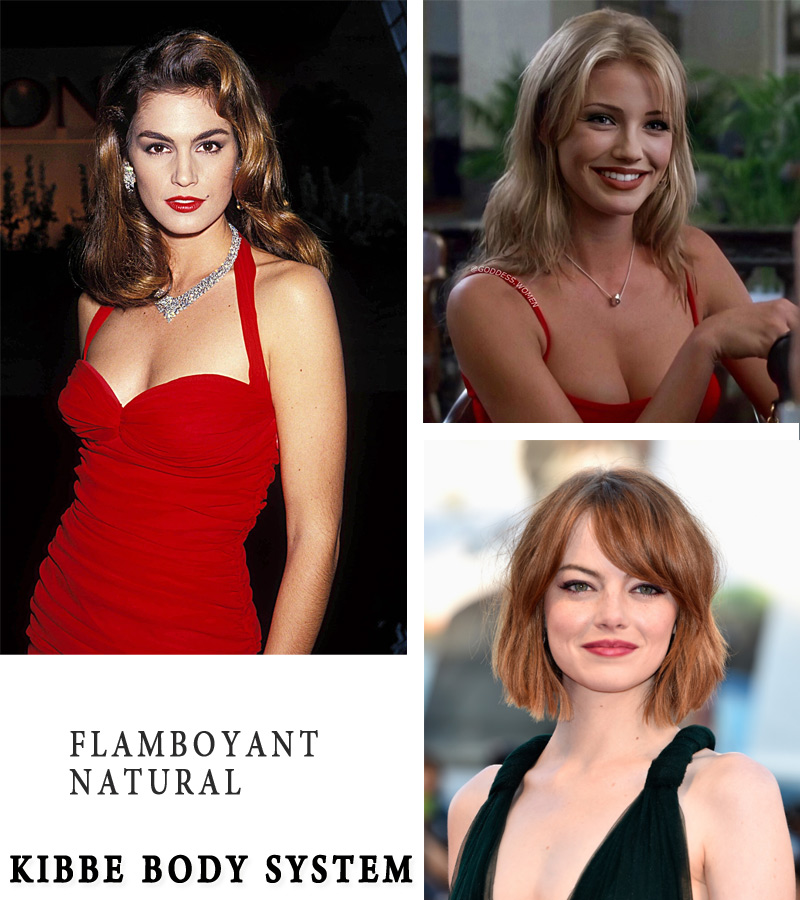
The Flamboyant Natural body has long arms and legs, plus a noticeably vertical skeleton and wide shoulders and back.
This type has blunt edges and none of the narrowness of a Dramatic, but rather a wide overall look.
They may have what Kibbe described as, ‘conventional curve’, that is they can have curves, but are not as obviously curvy as a Soft Dramatic shape. FB’s are ‘frame dominant’, as opposed to SD’s who are, ‘curve dominant’.
FN’s have a wider rib cage and don’t need to always wear waist-emphasizing clothes, like the SD type. Moreover, they have broader, blunt but not angled, facial features.
Examples include: Eva Mendes, Emma Stone, Cameron Diaz, Cindy Crawford and Gigi Hadid
8. Theatrical Romantic (TR) – Extreme Yin with a dash of Yang
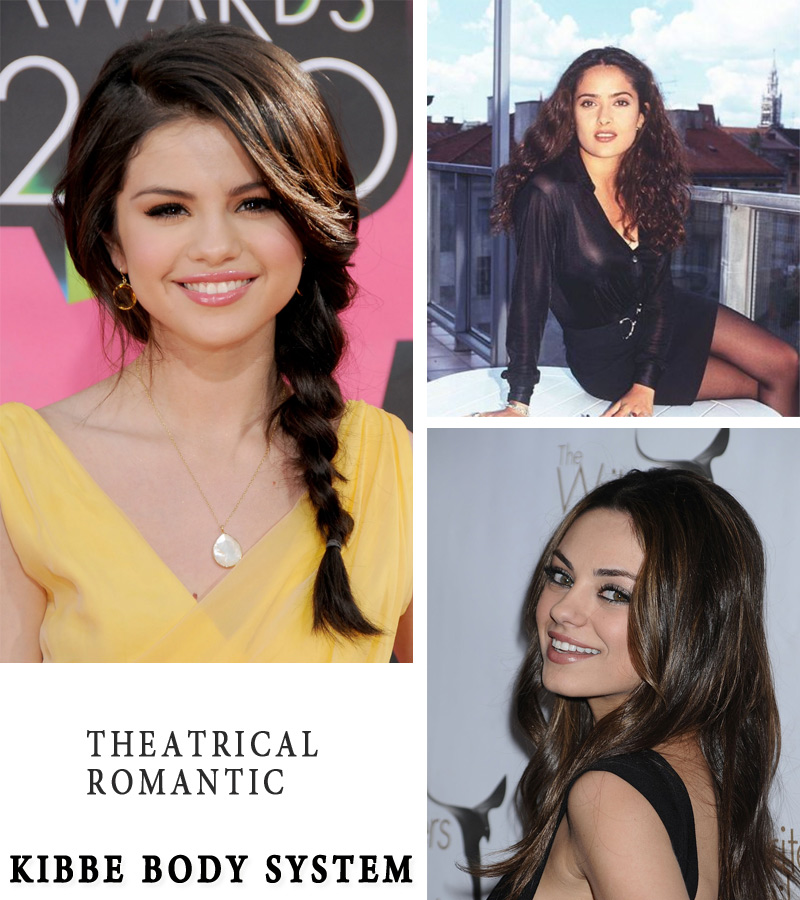
Theatrical Romantic body shapes are closely linked with the Romantic group, and have a flesh-dominant body type with short bones.
TR’s are small, at less than 5’ 5” in height with a curvier than average shape. They have soft flesh and curves with soft arms, legs and shoulder structure.
The faces of a typical TR have dainty, Yin features, but may also have a few sharper edges in their cheekbones, nose shape and jaw, which is Yang.
Examples include: Jada Pinkett-Smith, Vivien Leigh, Selena Gomez, Selma Hayak and Mila Kunis
How much has the Kibbe Body Type system been updated?
David Kibbe’s Book, Metamorphosis, was published in 1987, so it makes sense that the system itself has evolved since then. Here are some things to keep in mind:
1. The Kibbe system is not an all-encompassing method that works for everyone.
Since the 1980’s, fashion styles have evolved tremendously and while some people will find the system extremely beneficial, it is true that others may not see their body type clearly represented.
2. Your Image Identity can only be arrived at by looking honestly at your entire body without bias.
3. Non-binary people are included and respected in the updated Kibbe system.
4. Height is a strong factor in categorizing your type, for example, there are no tall Gamines and to fit this group you must be 5’ 5” or less in height.
5. Anyone over 5’ 7” is automatically Dramatic, Soft Dramatic, or Flamboyant Natural, because height automatically makes your type have Yang characteristics.
Therefore, if you are someone who identifies as a woman, as a cross-dresser or Trans, remember to choose from those 3 options.
6. Your overall bone structure and how/where your flesh lies on it is far more significant than your bust, waist and hip measurement.
7. Kibbe now feels that your body is more important than your facial features when choosing your correct category from the 13 choices.
8. Kibbe removed the Pure Natural, Pure Classic and Pure Gamine style identities – as the majority of individuals don’t exhibit this perfect state between Yin and Yang.
9. The modernized system has fewer sub-groups for the Dramatic, Classic, Natural, Gamine and Romantic as Kibbe believes they are more extreme and possibly need to be assessed by himself, as the original founder of the system.
Ready to take the Kibbe Body Type Quiz?
Finally, this system can be a great way to improve your style image, help you dress better and stop wasting money on clothes that don’t flatter your shape.
On the other hand, it isn’t a scientific certainty and you should only treat it as a style ‘aid’. Please don’t feel anxious if you find it difficult to work out exactly what type you are!
It does take time to identify your true body shape in the Kibbe system, so be kind and patient with yourself.
Remember that a trusted friend or family member can be a great help in deciding between two characteristics.
That’s the end of this Kibbe Body Types introduction, so your next step is to take the Kibbe Body Types Test! Have fun!
